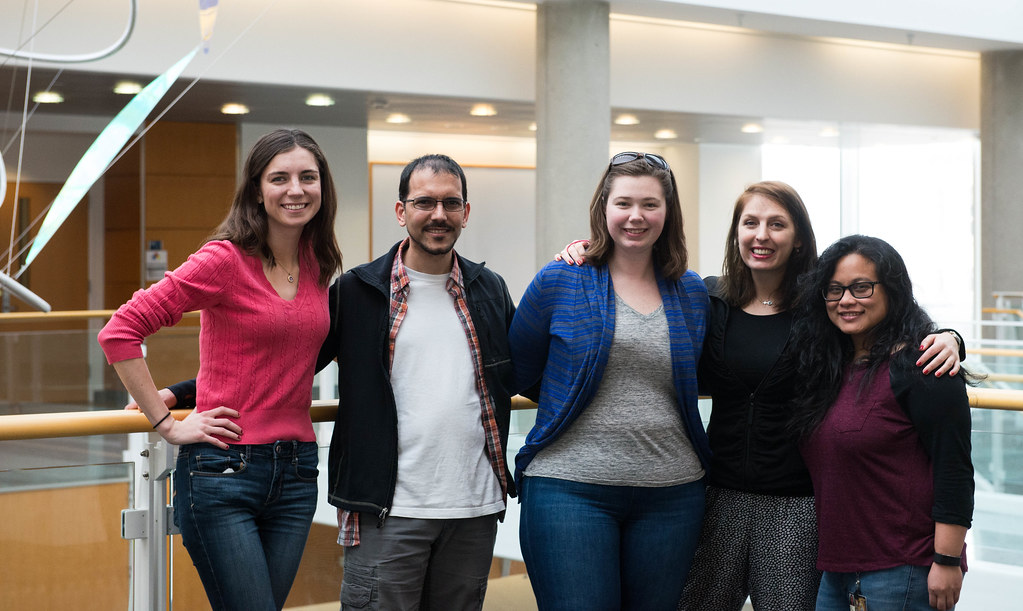
Jinghong Chen | Bond Life Sciences Center
Since eight years old, Beverly Agtuca knew she wanted to be a scientist.
A trip to Philippines changed Agtuca, an American-born Filipino, and inspired her passion on plants.
“My grandma always told me to work in the field all day so that they can have enough food for us to eat,” Agtuca said. “The life [in Philippines] is so different from here…I want to not just provide food but be that scientist trying to figuring something out, and hopefully saving the world.”
Agtuca is on her way to her dream. She is now a third year doctoral student in Gary Stacey’s lab at Bond Life Sciences Center with a focus on nitrogen-fixing bacteria.
Although she has been involved in research since high school, Agtuca recently faced a new challenge of telling people about her work. The Preparing Tomorrow’s Leaders of Science class tasked her with making a 90-second video to explain her two-year study to the general public.
Her team, “The A Team,” chose to go with the benefits of having nitrogen-fixing bacteria.
For decades, people have been adding nitrogen fertilizers to plants to improve yields, but this can lead to pollution in water systems and ecosystems. Scientists need to enhance plant productivity to meet a huge food demand by the year of 2050.
One little bacteria might make this possible and save the world. Rhizobia, a type of natural bacteria in soil, are able to fix nitrogen via biological nitrogen fixation. These bacteria can convert nitrogen gas into ammonia as a plant nutrient source, while the plants give all the carbon sources back to the bacteria.
“It is like a walky-talky,” Agtuca said. “They are communicating with each other.”
Yet before speaking to the public, Agtuca needs to explain the plant-bacteria interaction to her teammates. Students less well versed in science like Jessica Kaiser, a strategic communication student, thinks of science differently.
“The biggest issue we ran into is jargon, like basic science words that [my teammates] are so comfortable with,” Kaiser said. “We need to focus on what people care about instead of the technical sides, to focus on why it matters to anybody rather than just to a science person.”
Within two weeks, they produced the video “Good Microbes: reducing pollution one farm at a time.” Along with two other teams, their videos will be commented and judged by representatives from Monsanto.

The 90-second video is just a glimpse of Agtuca’s study. In the last two years she has been focusing on the use of a new technique — laser ablation electrospray ionization mass spectrometry (LAESI-MS) — that does in situ metabolic profiling of tissues. The lab is using LAESI-MS to investigate the metabolites in a well-characterized model plant-rhizobium system, specifically nitrogen-fixing soybean nodules resulting from root infection by the symbiotic bacterium Bradyrhizobium japonicum.
This work includes a huge collaboration that was developed through a Department of Energy (DOE) grant involving the George Washington University, Washington D.C. and the Environmental Molecular Science Laboratory (EMSL), Pacific Northwest National Laboratory, Richland, WA.
LAESI-MS works like a superhero’s laser-like beams. You first aim the laser on the sample, which then heats it and causes neutral particles to be released into the air. This plume of neutrals is then captured and ionized by the electrospray, and finally analyzed by the spectrometer to figure out the exactly what metabolites in nodules are involved in biological nitrogen fixation.
“It takes about three seconds to analyze one sample using this LAESI-MS technique,” Agtuca said. Other metabolic techniques require extensive pre-treatment of the sample before analysis.
By analyzing the data collected via LAESI-MS, the lab is able to confirm that future plant studies could apply this new approach to understand the interactions between plant and bacteria.
Agtuca’s research is a long way from her first experiences with plants. She still remembers the moment she found her plants in her own garden died. She was less than 10 years old, yet devoted to taking care of her plants with water and fertilizers.
“I was really sad. I could not get my tomatoes, peppers and eggplants to live.…That makes me think that I want to answer why they didn’t grow,” Agtuca said.
More than ever, her future is helping her answer those question for herself.
Gary Stacey is a Bond LSC investigator and MU curators’ professor of plant science and MSMC endowed professor of soybean biotechnology. Read more here about Stacey lab.
Sven Nelson is a USDA/ARS postdoctoral research scientist at the University of Missouri. Anna Glowinski is a Ph.D. student in the USDA/ARS lab. Jessica Kaiser is a graduate student in strategic communication. Eleni Galata works as the team mentor and she is a Ph.D. student in agricultural and applied economics at MU.

